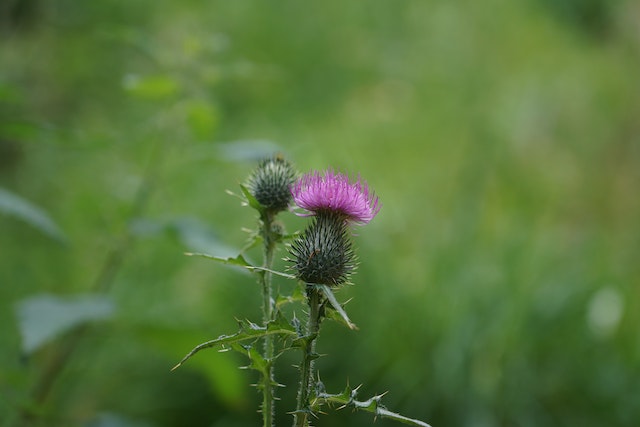Botanical Description:
Scientific Name: Silybum marianum
Common Names: Milk Thistle, St. Mary’s Thistle
Description:
Milk Thistle is an annual or biennial herb belonging to the Asteraceae family. Native to the Mediterranean region, it is recognized by its spiky leaves and distinctive purple-pink flowers. The seeds of the Milk Thistle plant contain bioactive compounds, particularly silymarin, which have been extensively studied for their potential therapeutic effects.
Disclaimer:
This Materia Medica is provided for informational purposes only and should not replace professional medical advice. Please consult with a qualified healthcare practitioner or herbalist before using any herbal remedies.
Therapeutic Actions:
- Liver Support:
- Milk Thistle is renowned for its hepatoprotective effects, supporting liver health and regeneration.
- Antioxidant:
- Exhibits antioxidant properties, helping to protect cells from oxidative stress.
- Anti-Inflammatory:
- Displays anti-inflammatory effects, contributing to its role in addressing inflammatory conditions.
- Cholesterol Regulation:
- Studied for its potential benefits in regulating cholesterol levels.
Constituents:
- Silymarin:
- A complex of flavonoids, including silibinin, silychristin, and silydianin, responsible for many of Milk Thistle’s medicinal properties.
- Flavonoids:
- Contribute to the overall antioxidant effects of Milk Thistle.
- Beta-Carotene:
- Adds to the plant’s antioxidant content.
Traditional Uses:
- Liver Conditions:
- Milk Thistle has a long history of use in supporting liver conditions, including cirrhosis, hepatitis, and fatty liver disease.
- Detoxification:
- Employed for its potential role in detoxification and cleansing the liver.
- Digestive Health:
- Used traditionally to support overall digestive health.
Dosage and Preparation:
- Milk Thistle Extract:
- Standardized milk thistle extracts are commonly available in capsule or liquid form. Dosages vary but often range from 140 to 420 mg per day.
- Milk Thistle Tea:
- Infusions made using crushed Milk Thistle seeds. Dosage may vary, and it’s essential to follow recommended guidelines.
Cautions and Considerations:
- Allergies:
- Individuals with known allergies to plants in the Asteraceae family should exercise caution.
- Pregnancy and Breastfeeding:
- Safety during pregnancy and breastfeeding is not well-established, and consultation with a healthcare professional is recommended.
- Interactions:
- Potential interactions with medications, particularly those affecting the liver; consultation with healthcare professionals is essential.
Conclusion:
Milk Thistle, with its spiky leaves and potent seeds, stands as a prominent herb in herbal medicine, particularly in supporting liver health. From its hepatoprotective and antioxidant effects to its potential anti-inflammatory properties, Milk Thistle offers a range of therapeutic actions. Whether taken as standardized extracts or infused as a tea, Milk Thistle provides accessible options for those seeking natural remedies. However, caution is advised, especially for individuals with allergies or specific health concerns. This Exhaustive Materia Medica aims to provide comprehensive insights into Milk Thistle’s botanical description, therapeutic actions, constituents, traditional uses, dosage, precautions, and applications. For personalized guidance, consultation with healthcare professionals or herbalists is recommended, ensuring safe and effective utilization of Milk Thistle as a herbal remedy.







One comment on “Milk Thistle: Herbal Plant Profile”